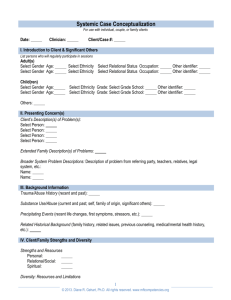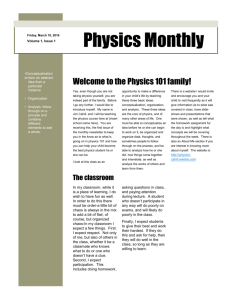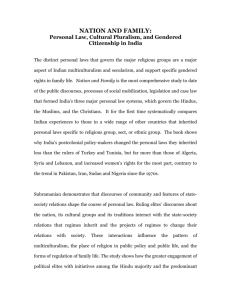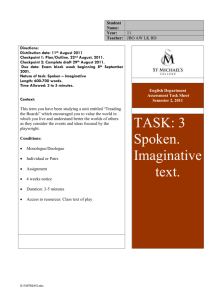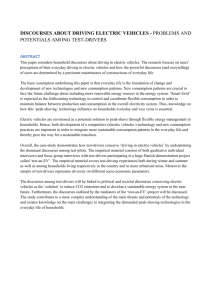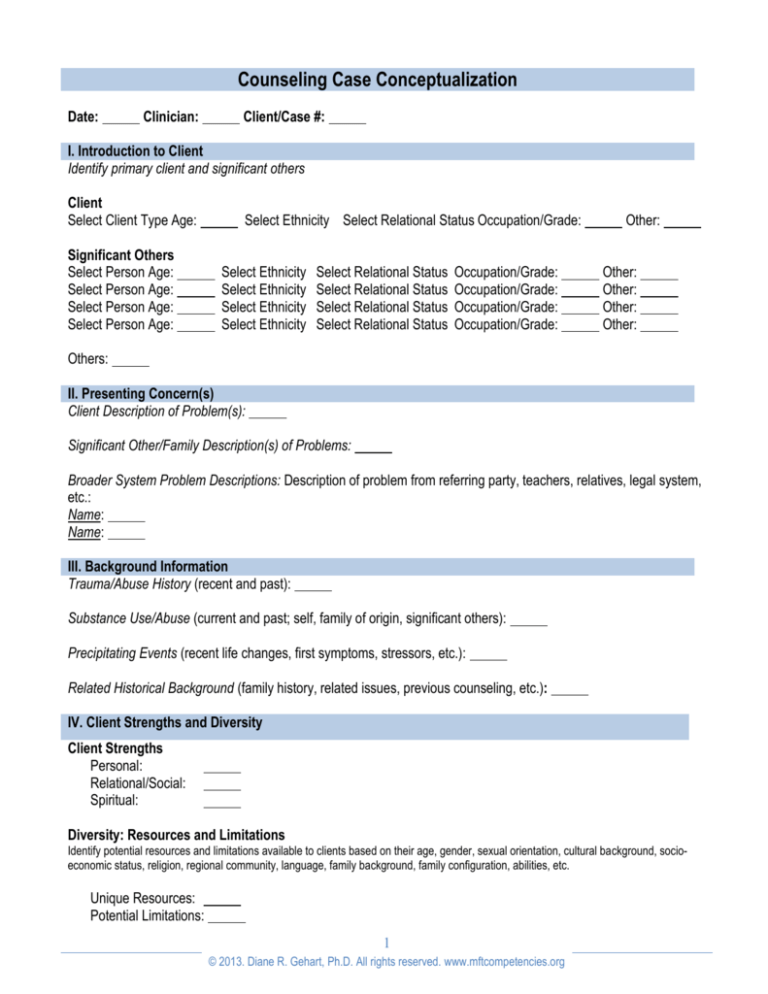
Counseling Case Conceptualization
Date:
Clinician:
Client/Case #:
I. Introduction to Client
Identify primary client and significant others
Client
Select Client Type Age:
Significant Others
Select Person Age:
Select Person Age:
Select Person Age:
Select Person Age:
Select Ethnicity Select Relational Status Occupation/Grade:
Select Ethnicity
Select Ethnicity
Select Ethnicity
Select Ethnicity
Select Relational Status
Select Relational Status
Select Relational Status
Select Relational Status
Occupation/Grade:
Occupation/Grade:
Occupation/Grade:
Occupation/Grade:
Other:
Other:
Other:
Other:
Other:
Others:
II. Presenting Concern(s)
Client Description of Problem(s):
Significant Other/Family Description(s) of Problems:
Broader System Problem Descriptions: Description of problem from referring party, teachers, relatives, legal system,
etc.:
Name:
Name:
III. Background Information
Trauma/Abuse History (recent and past):
Substance Use/Abuse (current and past; self, family of origin, significant others):
Precipitating Events (recent life changes, first symptoms, stressors, etc.):
Related Historical Background (family history, related issues, previous counseling, etc.):
IV. Client Strengths and Diversity
Client Strengths
Personal:
Relational/Social:
Spiritual:
Diversity: Resources and Limitations
Identify potential resources and limitations available to clients based on their age, gender, sexual orientation, cultural background, socioeconomic status, religion, regional community, language, family background, family configuration, abilities, etc.
Unique Resources:
Potential Limitations:
1
© 2013. Diane R. Gehart, Ph.D. All rights reserved. www.mftcompetencies.org
Complete All of the Following Sections for a Complete Case Conceptualization or Specific Sections for TheorySpecific Conceptualization.
V. Psychodynamic Conceptualization
Psychodynamic Defense Mechanisms
Check 2-4 most commonly used defense mechanisms
Acting Out: Describe:
Denial: Describe:
Displacement: Describe:
Help-rejecting complaining: Describe:
Humor: Describe:
Passive Aggression: Describe:
Projection: Describe:
Projective Identification: Describe:
Rationalization: Describe:
Reaction Formation: Describe:
Repression: Describe:
Splitting: Describe:
Sublimation: Describe:
Suppression: Describe:
Other:
Object Relational Patterns
Describe relationship with early caregivers in past:
Was the attachment with the mother (or equivalent) primarily:
Generally Secure
Anxious and Clingy
Avoidant and Emotionally Distant
Was the attachment with the father (or equivalent) primarily:
Generally Secure
Anxious and Clingy
Avoidant and Emotionally Distant
Describe present relationship with these caregivers:
Describe relational patterns with partner and other current relationships:
Erickson’s Psychosocial Developmental Stage
Describe development at each stage up to current stage
Trust vs. Mistrust (Infant stage):
Autonomy vs. Shame and Doubt (Toddler stage):
Initiative vs. Guilt (Preschool age):
Industry vs. Inferiority (School age):
Identity vs. Role Confusion (Adolescence):
Intimacy vs. Isolation (Young adulthood):
Generativity vs. Stagnation (Adulthood):
Ego Integrity vs. Despair (Late Adulthood):
Adlerian Style of Life Theme
Control:
Superiority:
Pleasing:
2
© 2013. Diane R. Gehart, Ph.D. All rights reserved. www.mftcompetencies.org
Other:
Other:
Comfort:
Basic Mistake Misperceptions:
VI. Humanistic-Existential Conceptualization
Expression of Authentic Self
Problems: Are problems perceived as internal or external (caused by others, circumstance, etc.)?
Predominantly internal
Mixed
Predominantly external
Agency and Responsibility: Is self or other discussed as agent of story? Does client take clear responsibility for
situation?
Strong sense of agency and responsibility
Agency in some areas
Little agency; frequently blames others/situation
Often feels victimized
Recognition and Expression of Feelings: Are feelings readily recognized, owned, and experienced?
Easily expresses feelings
Identifies feelings with prompting
Difficulty recognizing feelings
Here-and-Now Experiencing: Is the client able to experience full range of feelings as they are happening in the
present moment?
Easily experiences emotions in present moment
Experiences some present emotions with assistance
Difficulty with present moment experiencing
Personal Constructs and Facades: Is the client able to recognize and go beyond roles? Is identity rigid or
tentatively held?
Tentatively held; able to critique and question
Some awareness of facades and construction of identity
Identity rigidly defined; seems like “fact”
Complexity and Contradictions: Are internal contradictions owned and explored? Is client able to fully engage the
complexity of identity and life?
Aware of and resolves contradictions
Some recognition of contradictions
Unaware of internal contradictions
Shoulds: Is client able to question socially imposed shoulds and oughts? Can client balance desire to please
others and desire to be authentic?
Able to balance authenticity with social obligation
Identifies tension between social expectations and personal desires
Primarily focuses on external shoulds
List shoulds:
Acceptance of Others: Is client able to accept others and modify expectations of others to be more realistic?
Readily accepts others as they are
Recognizes expectations of others are unrealistic but still strong emotional reaction to expectations not
being met
Difficulty accepting others as is; always wanting others to change to meet expectations
Trust of Self: Is client able to trust self as process (rather than a stabile object)?
Able to trust and express authentic self
3
© 2013. Diane R. Gehart, Ph.D. All rights reserved. www.mftcompetencies.org
Trust of self in certain contexts
Difficulty trusting self in most contexts
Existential Analysis
Sources of Life Meaning (as described or demonstrated by client):
General Themes of Life Meaning:
Personal achievement/work
Significant other
Children
Family of origin
Social cause/contributing to others
Religion/spirituality
Other:
Satisfaction with and clarity on life direction:
Clear sense of meaning that creates resilience in difficult times
Current problems require making choices related to life direction
Minimally satisfied with current life direction; wants more from life
Has reflected little on life direction up to this point; living according to life plan defined by
someone/something else
Other:
Gestalt Contact Boundary Disturbances
Desensitization: Failing to notice problems
Introjection: Take in others’ views whole and unedited
Projection: Assign undesired parts of self to others
Retroflection: Direct action to self rather than other
Deflection: Avoid direct contact with another or self
Egotism: Not allowing outside to influence self
Confluence: Agree with another to extent that boundary blurred
Describe:
VII. Cognitive-Behavioral Conceptualization
Baseline of Symptomatic Behavior
Symptom #1 (behavioral description):
Frequency:
Duration:
Context(s):
Events Before:
Events After:
Symptom #2 (behavioral description):
Frequency:
Duration:
Context(s):
Events Before:
Events After:
4
© 2013. Diane R. Gehart, Ph.D. All rights reserved. www.mftcompetencies.org
A-B-C Analysis of Irrational Beliefs
Activating Event (“Problem”):
Consequence (Mood, behavior, etc.):
Mediating Beliefs (Unhelpful beliefs about event that result in C):
1.
2.
3.
Beck’s Schema Analysis
Identify frequently used cognitive schemas:
Arbitrary inference:
Selective abstraction:
Overgeneralization:
Magnification/Minimization:
Personalization:
Absolutist/dichotomous thinking:
Mislabeling:
Mindreading:
VIII. Family Systems Conceptualization
Family Life Cycle Stage
Single adult
Marriage
Family with Young Children
Family with Adolescent Children
Launching Children
Later Life
Describe struggles with mastering developmental tasks in one of these stages:
Boundaries with
Parents
Enmeshed
Clear
Disengaged
Significant Other
Enmeshed
Clear
Disengaged
Children
Enmeshed
Clear
Disengaged
Extended Family
Enmeshed
Clear
Disengaged
Other: Name
Enmeshed
Clear
Disengaged
Typical style for regulating closeness and distance with others:
NA: Describe:
NA: Describe:
NA: Describe:
NA: Describe:
NA: Describe:
Triangles/Coalitions
Coalition in family of origin: Describe:
Coalitions related to significant other: Describe:
Other coalitions:
Hierarchy between Self and Parent/Child
NA
With own children
Effective
With parents (for child/young adult)
Effective
Rigid
Rigid
Permissive
Permissive
Complementary Patterns with Name:
5
© 2013. Diane R. Gehart, Ph.D. All rights reserved. www.mftcompetencies.org
Pursuer/distancer
Over/under-functioner
Emotional/logical
Good/bad parent
Other: Describe
Example of complementary pattern:
Intergenerational Patterns
Substance/Alcohol Abuse:
Sexual/Physical/Emotional Abuse:
Parent/Child Relations:
Physical/Mental Disorders:
Family strengths:
Describe:
NA
NA
NA
NA
History:
History:
History:
History:
IX. Solution-Based and Cultural Discourse Conceptualization (Postmodern)
Solutions and Unique Outcomes
Attempted Solutions that DIDN’T or DON’T work:
1.
2.
3.
Exceptions and Unique Outcomes: Times, places, relationships, contexts, etc. when problem is less of a problem;
behaviors that seem to make things even slightly better:
1.
2.
3.
Miracle Question Answer: If the problem were to be resolved overnight, what would client be doing differently the
next day? (Describe in terms of doing X rather than not doing Y).
1.
2.
3.
Dominant Discourses informing definition of problem:
Ethnic, Class and Religious Discourses: How do key cultural discourses inform what is perceived as a problem
and the possible solutions?
Gender and Sexuality Discourses: How do the gender/sexual discourses inform what is perceived as a problem
and the possible solutions?
Community, School, and Extended Family Discourses: How do other important community discourses inform
what is perceived as a problem and the possible solutions?
Identity Narratives: How has the problem shaped each client’s identity?
Local or Preferred Discourses: What is the client’s preferred identity narrative and/or narrative about the problem?
Are there local (alternative) discourses about the problem that are preferred?
6
© 2013. Diane R. Gehart, Ph.D. All rights reserved. www.mftcompetencies.org

